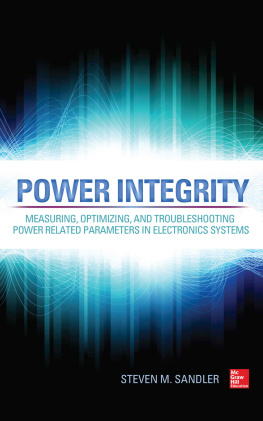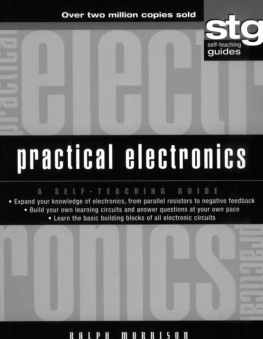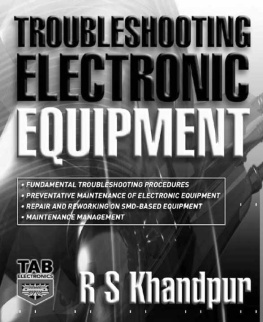Electronic Measuring Instruments
Learn Electronics
I would like to dedicate the book to the students who will be using it. I wish you future career success and hope you never stop learning.
Contents
Preface
This book is meant to provide our readers conceptual knowledge about various electronic measuring instruments and how to choose a specific measuring instrument based on their requirement. There are two types of measuring instruments: one is the type of measuring instruments that show the values on the scale of the meter, and other are type of measuring instruments that displays the waveforms.
This book is meant for all the readers who are aspiring to learn the concepts of Electronic Measurements and Instrumentation.
The fundamental concepts covered in Network Theory & Electronic Circuits books will be useful for understanding the concepts discussed in this book.
Introduction
The instruments, which are used to measure any quantity are known as measuring instruments. This tutorial covers mainly the electronic instruments , which are useful for measuring either electrical quantities or parameters.
Following are the most commonly used electronic instruments.
- Voltmeter
- Ammeter
- Ohmmeter
- Multimeter
Now, let us discuss about these instruments briefly.
Voltmeter
As the name suggests, voltmeter is a measuring instrument which measures the voltage across any two points of an electric circuit. There are two types of voltmeters: DC voltmeter, and AC voltmeter.
DC voltmeter measures the DC voltage across any two points of an electric circuit, whereas AC voltmeter measures the AC voltage across any two points of an electric circuit. An example of practical DC voltmeter is shown in below figure.
The DC voltmeter shown in above figure is a (0100)V (0100)V DC voltmeter . Hence, it can be used to measure the DC voltages from zero volts to 10 volts.
Ammeter
As the name suggests, ammeter is a measuring instrument which measures the current flowing through any two points of an electric circuit. There are two types of ammeters: DC ammeter, and AC ammeter.
DC ammeter measures the DC current that flows through any two points of an electric circuit. Whereas, AC ammeter measures the AC current that flows through any two points of an electric circuit. An example of practical AC ammeter is shown in below figure
The AC ammeter shown in above figure is a (0100)A (0100)A AC ammeter . Hence, it can be used to measure the AC currents from zero Amperes to 100 Amperes.
Ohmmeter
Ohmmeter is used to measure the value of resistance between any two points of an electric circuit. It can also be used for finding the value of an unknown resistor. There are two types of ohmmeters: series ohmmeter, and shunt ohmmeter.
In series type ohmmeter, the resistor whose value is unknown and to be measured should be connected in series with the ohmmeter. It is useful for measuring high values of resistances .
In shunt type ohmmeter, the resistor whose value is unknown and to be measured should be connected in parallel (shunt) with the ohmmeter. It is useful for measuring low values of resistances .
An example of practical shunt ohmmeter is shown in the above figure. The ohmmeter shown in above figure is a (0100) (0100) shunt ohmmeter . Hence, it can be used to measure the resistance values from zero ohms to 100 ohms.
Multimeter
Multimeter is an electronic instrument used to measure the quantities such as voltage, current & resistance one at a time. It can be used to measure DC & AC voltages, DC & AC currents and resistances of several ranges. A practical multimeter is shown in the following figure
As shown in the figure, this multimeter can be used to measure various high resistances, low resistances, DC voltages, AC voltages, DC currents, & AC currents. Different scales and range of values for each of these quantities are marked in above figure.
The instruments which we considered in this chapter are of indicating type instruments , as the pointers of these instruments deflect and point to a particular value. We will discuss about these electronic measuring instruments in detail in later chapters.
Performance Characteristics
The characteristics of measurement instruments which are helpful to know the performance of instrument and help in measuring any quantity or parameter, are known as Performance Characteristics .
Types of Performance Characteristics
Performance characteristics of instruments can be classified into the following two types .
- Static Characteristics
- Dynamic Characteristics
Now, let us discuss about these two types of characteristics one by one.
Static Characteristics
The characteristics of quantities or parameters measuring instruments that do not vary with respect to time are called static characteristics. Sometimes, these quantities or parameters may vary slowly with respect to time. Following are the list of static characteristics .
- Accuracy
- Precision
- Sensitivity
- Resolution
- Static Error
Now, let us discuss about these static characteristics one by one.
Accuracy
The algebraic difference between the indicated value of an instrument, A i Ai and the true value, A t At is known as accuracy . Mathematically, it can be represented as
Accuracy=A i A t Accuracy=AiAt
The term, accuracy signifies how much the indicated value of an instrument, A i Ai is closer to the true value, A t At.
Static Error
The difference between the true value, A t At of the quantity that does not vary with respect to time and the indicated value of an instrument, A i Ai is known as static error , e s es. Mathematically, it can be represented as
e s =A t A i es=AtAi
The term, static error signifies the inaccuracy of the instrument. If the static error is represented in terms of percentage, then it is called percentage of static error . Mathematically, it can be represented as
%e s =e s A t %es=esAt100
Substitute, the value of e s es in the right hand side of above equation
%e s =A t A i A t %es=AtAiAt100
Where,
%e s %es is the percentage of static error.
Precision
If an instrument indicates the same value repeatedly when it is used to measure the same quantity under same circumstances for any number of times, then we can say that the instrument has high precision .
Sensitivity
The ratio of change in output, A out Aout of an instrument for a given change in the input, A in Ain that is to be measured is called sensitivity, S . Mathematically it can be represented as
S=A out A in S=AoutAin
The term sensitivity signifies the smallest change in the measurable input that is required for an instrument to respond.





















